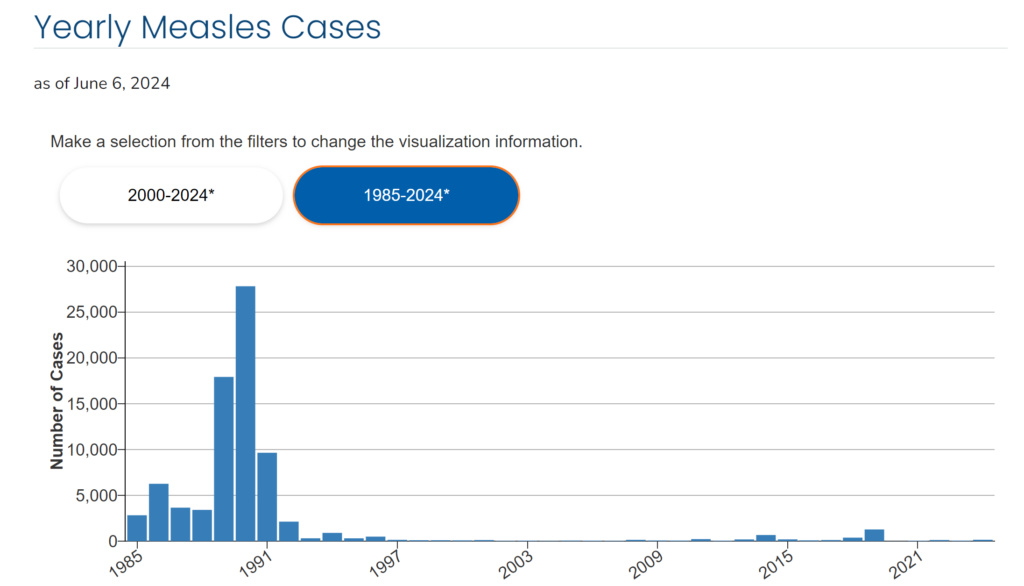An independent researcher. We encourage readers to verify information.
Kennedy Debunked | Vol. 1
Kennedy Debunked
Explore Debunks
Explore Debunks
Reality: The CDC data shows that measles has never been entirely eradicated in the United States. Although there was a rise in measles cases following the easing of lockdowns and travel restrictions in 2020, this was to be expected. The majority of measles cases in the U.S. are imported, meaning they are brought in by travelers who contract the disease abroad and then bring it into the country. With the lifting of travel bans, the number of imported cases naturally increased. However, it is important to note that the overall number of measles cases has dropped significantly since 2019.
Measles Never Went Away
Contrary to popular belief, measles has never been completely eliminated from the United States. Measles cases have been recorded every year. Nearly all measles cases were imported cases, meaning a traveler was exposed abroad and brought it into the U.S.
Below is a breakdown of measles cases by year from the CDC, highlighting the fluctuation in case numbers and the presence of measles in the U.S. even before the recent debates over vaccination:

2019 Measles Outbreak
The 2019 measles outbreak in the United States saw a significant rise in cases, from 381 in 2018 to 1,274 in 2019. This increase is often cited as evidence of a resurgence linked to anti-vaccine rhetoric. However, the details of the outbreak reveal a different story. According to a New England Journal of Medicine analysis, the outbreak began when one unvaccinated child returned home from abroad with measles, triggering a localized outbreak in New York City.
This was not a widespread outbreak across the entire U.S. but rather a concentrated incident in the Williamsburg area. 72.9% of cases between September 30, 2018, and July 15, 2019 were from this area.
Understanding Vaccination and Reporting Bias
The New England Journal of Medicine study reports that “85.8% of the patients with a known vaccination history were unvaccinated.” This statistic is often used to argue that unvaccinated individuals are primarily responsible for measles outbreaks. However, it’s important to note potential biases in reporting vaccinated cases. The study highlights that:
“Because of the potential for a false positive IgM assay, patients who lacked clinical information and had only a positive IgM assay were included only if they were confirmed to be unvaccinated, since the likelihood of a true infection would increase in the absence of vaccination.”
This suggests that vaccinated cases may have been underreported due to the exclusion of cases that could not be confirmed through clinical information. The bias towards reporting unvaccinated cases can skew the perception of the role of vaccination in measles outbreaks.
Mumps Outbreak Among Vaccinated
Interestingly, Brooklyn also experienced a mumps outbreak in 2009. The analysis of the 2009 mumps outbreak provides critical insights:
“Transmission was focused within… schools for boys, where students spend many hours daily in intense, face-to-face interaction… The epidemiologic features of this outbreak suggest that intense exposures, particularly among boys in schools, facilitated transmission and overcame vaccine-induced protection in these patients.”
The mumps outbreak, which occurred among a highly vaccinated population, was driven by the high-density, close-contact environment of the schools, which facilitated the spread of the virus despite vaccination. This context is crucial for understanding the dynamics of infectious diseases. Vaccination is never 100% effective and other factors can contribute to an outbreak.

Data Insights from CDC Reports and Studies
According to a CDC analysis, “During January 1, 2020–March 28, 2024, CDC was notified of 338 confirmed measles cases; 97 (29%) of these cases occurred during the first quarter of 2024, representing a more than seventeenfold increase over the mean number of cases reported during the first quarter of 2020–2023. However, this is expected as travel restrictions and lockdowns were in place in 2020. As we learned, most cases are imported. Travel restrictions being lifted are the primary reason for the increase in cases since 2020. It is notable to point out that the U.S. still has less cases so far in 2024 (151 measles cases) than in 2019, 2018. 2015, 2014, 2013, 2011, and more.
As you can see below, the highest vaccination year was also the year of the 2019 measles outbreak. According to the CDC, the vaccination rate for kindergarteners was 95.2%. Once again, this suggests that outbreaks are more nuanced than vaccination rates.

Who’s to Blame?
The claim that Robert F. Kennedy Jr. is responsible for the resurgence of measles is baseless and misleading. Data shows that measles has never been fully eradicated in the U.S., and recent outbreaks are primarily due to imported cases, not domestic anti-vaccine sentiment. The 2019 outbreak was localized in Williamsburg, Brooklyn, and caused by international travel, not a widespread anti-vaccine movement. High vaccination rates in 2019 and a similar mumps outbreak in 2009 in the same community illustrate that other factors, like close-contact environments, contribute to disease spread.
Blaming Kennedy is misleading and ignores the true causes of these outbreaks. It also ignores the fact that vaccination is never 100% effective and that while you may have a reduced risk of measles, mumps, and rubella, you can also have other side effects. “I think some of the live virus vaccines are probably averting more problems than they’re causing,” Kennedy told Lex Fridman. The CDC says, “There are risks in taking any medicine, vitamin or other supplement.” A person should have the bodily autonomy to weigh the risks and benefits for themselves to make an informed decision. Read more about his vaccine stance here. Kennedy is also running to end the chronic disease epidemic. We are paying more for healthcare than anywhere in the world but have the worst health outcomes. Read more about his policies here.